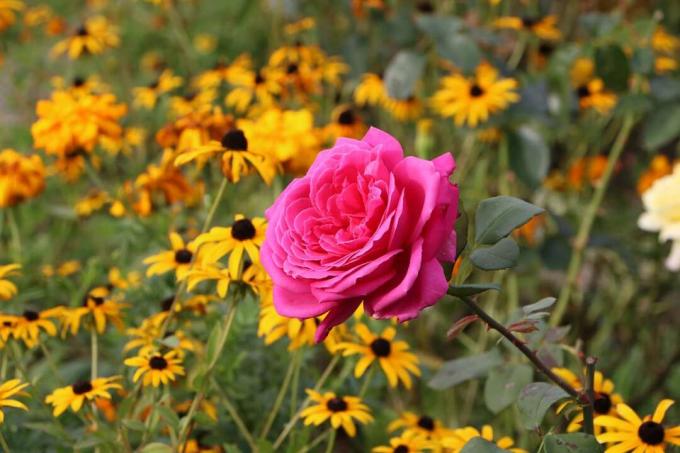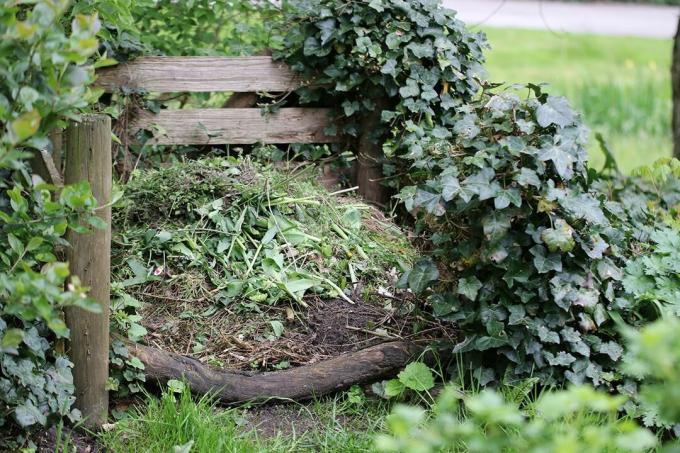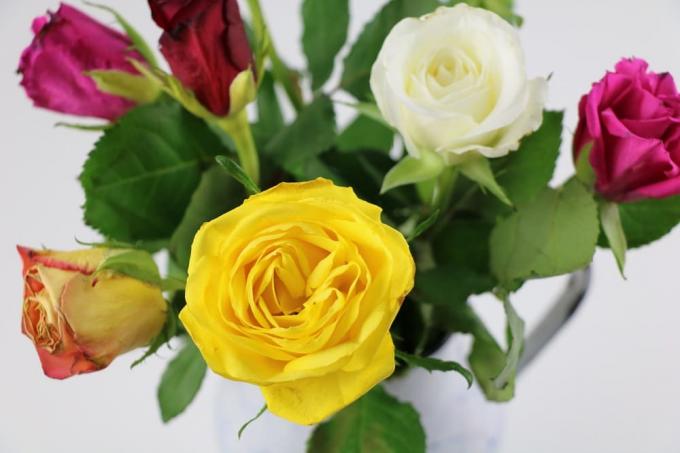

Table of contents
- needs of the roses
- The new substrate
- Mix rose soil yourself
- With fertilizer or without?
- work equipment
- Individual components and their meaning
- Instructions for making bucket soil
- Instructions for bed roses
Mixing substrate for roses yourself is not difficult. Only a few tools and components are required, which are easy to obtain.
needs of the roses
When roses are replanted, they impose certain conditions on the soil in which they are placed. There shouldn't have been any roses in the place where the roses are to be planted, the soil is exhausted and diseases could spread. The rose needs a permeable soil that does not dry out too quickly and is rich in humus and nutrients. Only then will the rose grow and bloom particularly persistently and luxuriantly. The correct pH is either neutral or slightly acidic.
The new substrate
Of course, the soil can be replaced, it is easier to look for a new place and just improve the substrate there. The situation is different with roses that are planted in pots. This substrate is completely remixed if you don't want to buy rose soil or just use any potting soil.
Composition of rose soil
Commercial rose soil consists of different components that depend on the manufacturer. Mostly included are:
- compost or peat
- volume
- fertilizer
- minerals
A notice:
Mycorrhizal fungi are added to some rose soils. They should improve the nutrient uptake of the roses.
Mix rose soil yourself
Making potting soil suitable for roses is not difficult. All you have to do is mix the necessary ingredients together in the right proportions. However, there are different options, depending on whether the plants are potted or bed roses.
With fertilizer or without?
It seems natural to fertilize roses when they are planted. Purchased rose soil almost always contains a long-term fertilizer that supplies the flowers with nutrients for several weeks.
However, it is not so easy to say whether this makes sense. A rose that you plant yourself should initially grow well and an extensive one Form root system, which the plant with nutrients and water even in lean and dry times can supply. For this reason, it is better not to fertilize the rose plant initially, or only a little, then the roots will have to grow longer and more branched in search of nutrients.
work equipment
What is needed to make the substrate depends on the amount being mixed. A bucket is enough for single roses. If an entire bed of roses is to be equipped with new substrate or if there are many balcony plants, a larger mason's bucket will do its job. Other necessary tools:
- shovel or hand shovel
- something to mix it up, a stick or an old wooden spoon for example
- Measuring cup, scale or smaller container to measure individual ingredients
Individual components and their meaning
topsoil or garden soil
There is enough normal garden soil in almost every garden, unless it is a completely new plant. Then topsoil can be obtained from various sources, such as a garden supply store. In your own garden, simply use the top layer of soil.
clay or clay
Since sandy soil stores nutrients and water poorly, it is upgraded with clay or loam. In loamy soils, the addition of additional clay is not necessary. Clay soil is available from building material suppliers.
Small grain bark mulch
Bark mulch can be helpful to improve the soil structure, especially if the soil is rather calcareous and needs to be acidified. It is important that the mulch has a very small grain size. Bark mulch is available from sawmills or garden stores.
compost
Well-rotted compost or manure gives the plants the nutrients they need. They are delivered evenly over a longer period of time. Compost is best obtained from your own garden. An alternative are public composting facilities.

rock flour
Primary rock flour improves the mineral composition and strengthens the plants. Rock flour is available from garden centers or online retailers.
lime
Lime addition only makes sense if the pH is in the low range and the soil is too acidic for roses. You can buy lime in hardware stores or garden stores.
Instructions for making bucket soil
- The main ingredient is garden soil or topsoil, which is filled into the bucket or a larger container.
- One part compost or decomposed manure is mixed with three parts garden soil.
- Substances for soil improvement, i.e. clay or lime, are now worked in. Here, too, one part to three parts of garden soil.
- Enough bark mulch is added to give the soil a loose, airy structure. The bark mulch improves the water storage capacity.
- Finally, mix all the rose soil with some rock flour. Since minerals only need to be present in trace amounts, two tablespoons per 10 liter bucket is sufficient.
- The self-made substrate is filled into the tubs and the roses are used.
Instructions for bed roses
Making potting soil for bed roses yourself is a bit more time-consuming, but can be done directly on site. The effort is worth it, as the roses are then supplied with minerals and nutrients for a long time.
- The size of the rose bed is staked out and the topsoil is dug up. Since the planting holes for roses must be deep enough so that the roots are not kinked, a depth of up to 40 cm can be assumed.
- Lay out a tarp next to the bed and pile the topsoil on it.
- Mix the garden soil with compost. Here, too, the rough mixing ratio is one part compost to three parts garden soil.
- Loosen the soil of the bed and mix with bark mulch. If the bed is threatened by voles, it makes more sense to spread rabbit wire on the substrate. The bark mulch is then mixed into the topsoil.
- If necessary, incorporate soil conditioner and some rock dust.
- Place the roses in the bed. Fill in the soil all around and press down a little. Finally, water the roses well.
A notice:
If other plants are planned in the rose bed, they are planted together with the roses.
 garden editorial
garden editorial I write about everything that interests me in my garden.
Learn more about roses

What goes with roses: 30 beautiful rose companions
The beauty of roses really comes into its own when surrounded by the right companion plants. It is important for rose companions that they have similar requirements to roses. We tell you what goes well with roses.

Rose cuttings: 8 tips for propagating roses
Roses can be propagated quite easily with the help of cuttings if the site conditions and the preparation are right. Both the time and the care play an important role in ensuring that the rose shoot takes root successfully and then thrives magnificently.

Combat rose pests | 10 typical pests on roses
Roses are the pride of many ornamental gardens. But in addition to diseases, pests also give you trouble again and again. Anyone who knows how to recognize and fight them can easily and quickly protect their darlings from most dangers.

Rose care in spring | 5 tips for the new season
The rose, the queen of flowers, should not be missing in any garden! If you want to enjoy the blooming splendor of bedding, hedge and climbing roses in summer, you have to start caring for the roses in spring. We have put together the most important information for you.

Caterpillars and Bugs on Roses: Spotting 16 Common Pests
Roses, the queen of flowers, impress with a variety of species and varieties. Their care is easy to difficult. This is in the eye of the beholder. However, care mistakes are only a danger for roses, because they are also popular with numerous pests.

Refining roses | When is the best time of year?
The interested layman can and may also propagate beautifully blooming hybrid tea roses for their own use by grafting. This is - if you know how it works - not difficult and easy to learn even for non-experts. Here we explain what you need to look out for.



